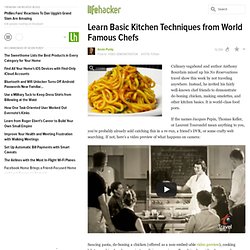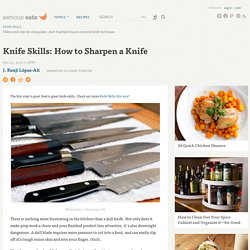

Cook Your Meat in a Beer Cooler: The World's Best (and Cheapest) Note: For a quick primer on the basics of sous-vide cooking, read our previous article here.

Prepping a beer cooler for low-temp cooking [Photographs: J. Kenji Lopez-Alt] By this point, there is absolutely no question that the method of cooking foods at precise low-temperatures in vacuum-sealed pouches (commonly referred to as "sous-vide") has revolutionized fine-dining kitchens around the world. There is not a Michelin-starred chef who would part easily with their Polyscience circulators.
But the question of when this technique will trickle down to home users—and it certainly is a question of when, and not if—remains to be answered. The Sous-Vide Supreme, introduced last winter, and of which I am a big fan, is certainly a big step in the right direction. A beer cooler is just as good at keeping hot things hot as it is at keeping cold things cold Here's how it works: A beer cooler is designed to keep things cool. 1. Before I even began, I threw in the towel as far as parts 3 and 4 go. Learn Basic Kitchen Techniques from World Famous Chefs - Cooking.
@tekgk: Haven't watched it yet, but the TiVo got it!

Sounds like an episode worth archiving for private use to me. @tekgk: Actually, I grew quite tired of his "www. [insert phrase of exclamation or delight here].com" but I do agree that he is one of the least phony out there. @tekgk: Love his approach to tv, food, different cultures, our food culture, etc. - very refreshing and real compared to the rest. I would suggest reading The Nasty Bits if you enjoy his demeanor as a chef and as a popular television personality. I also think Bourdain is absolutely correct by saying that culinary education should have expanded to include everyone instead of being hastily dropped from the curriculum - the American menu wouldn't be so bloated with crap like fast food if we all knew how to make a few decent meals for ourselves.
@Dont Know Me? Knife Skills: How to Sharpen a Knife. The first step to great food is great knife skills.

Check out more Knife Skills this way! [Photographs: J. Kenji Lopez-Alt] There is nothing more frustrating in the kitchen than a dull knife. Not only does it make prep work a chore and your finished product less attractive, it's also downright dangerous. Most home cooks should sharpen their knives at least twice a year, and much more frequently if they use their knives every day. Method 1: Use an Electric Sharpener. Method 2: Send it out to a professional. Method 3: Use a Sharpening Stone. That's where the following guide comes in. Shopping and Maintenance When buying a water stone, look for a large one, at least 2.5 inches wide by 8 inches long, and an inch in thickness. Bear in mind: The higher the grit, the sharper the edge you will get, but the more strokes it will take to get you there. I recommend keeping two stones in your kit.
You will also need a stone fixer to repair any inconsistencies in the surface of your sharpening stones. Top Ten Ways to Use Your Food Processor. It slices, it dices, it whips up a batch of summer pesto in no time!

My food processor is one of those multi-tasking kitchen tools that I really don't think I could live without at this point. Today, I thought I'd take a minute to ponder all the wonderful ways, big and small, that I use mine on a regular basis — making my life just a little bit easier in the process. Here's what I came up with: I have to admit something before diving in: I very rarely bother to dig out the other attachments and blades for my food processor. I just never got in the habit of using it to cut vegetables or other prep work.